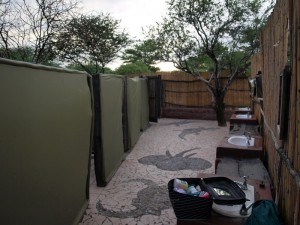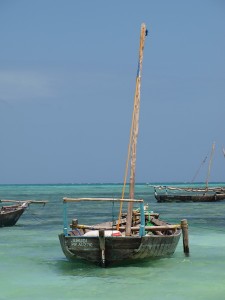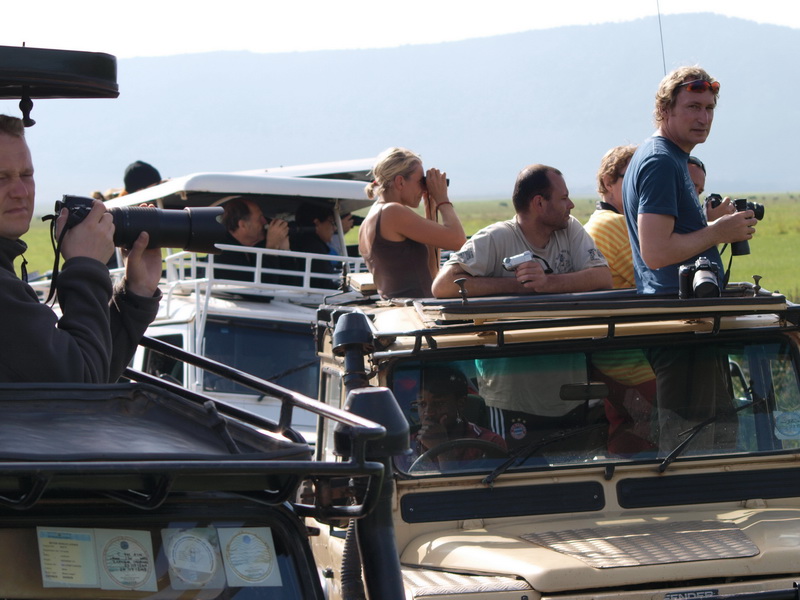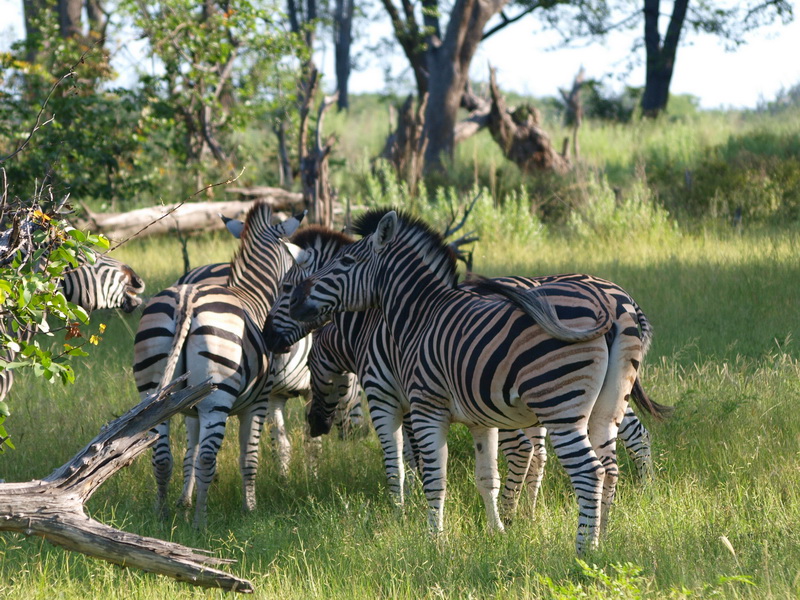Africa 2009
Trip Diary
January 13 to February 14 2009
Our trip to Africa in 2009 took us on a 30 day overland camping tour with Drifters from Johannesburg to Nairobi. We visited 7 countries along the way – South Africa, Botswana, Zimbabwe, Zambia, Malawi, Tanzania and Kenya. It gave us a great overview of southern Africa and left us wanting to return to explore areas in greater detail.
We left Johannesburg and headed up through the north of South Africa via Pretoria, Polokwane and Alldays, camping our first night at Machete in a Drifters owned camp. Here we learnt how to put up our tents and got to know better our truck that would be our home for the next 30 days. A short walk from camp there were some Bushmen paintings. Tonight was the first of many campfires and was a great start to our holiday.
We headed off towards the border at Martins Drift and made our way to Elephant Sands near Nata in Botswana. On the way we saw our first elephant on the side of the road, a great start to the trip! Elephant Sands was a fantastic campsite. It had a waterhole right in front of the bar and pool ar ea and we were lucky enough to have an elephant come and drink from it, just metres from where we were sitting. The showers were great. Open air, unisex and with walls made from canvas and reeds. Definitely a different experience to showering at home! We then made our way to Kasane where we stayed at Thebe River Camp. The camp had banded Mongoose running around all the tents. From here we headed off on our first game drive in Chobe. We saw hippos, impala, buffalo, warthog, kudu, crocodile, elephants, and our first lion, even if it was hidden in the grass in the distance!
ea and we were lucky enough to have an elephant come and drink from it, just metres from where we were sitting. The showers were great. Open air, unisex and with walls made from canvas and reeds. Definitely a different experience to showering at home! We then made our way to Kasane where we stayed at Thebe River Camp. The camp had banded Mongoose running around all the tents. From here we headed off on our first game drive in Chobe. We saw hippos, impala, buffalo, warthog, kudu, crocodile, elephants, and our first lion, even if it was hidden in the grass in the distance!
From Kasane we headed off the short distance to Victoria Falls, Zimbabwe, where we stayed at the Drifters Inn. When we were there the town was obviously suffering. The schools and shops were closed, there was no food to buy, there were no tourists staying there, their money was not worth anything and they were desperate to sell you what they could, although they never really begged (I’m glad to say that when we visited again just over 12 months later things  were definitely better). The falls themselves are amazing! While it is neither the highest nor the widest waterfall in the world, it is claimed to be the largest. This claim is based on a width of 1,708m and height of 108m, forming the largest sheet of falling water in the world. The falls were not at their fullest (which is usually around April), but even so, we got reasonably wet as we walked along the path beside them. A helicopter flight over them is well and truly worth it to fully comprehend how big they really are. The Victoria Falls Hotel is like stepping back in time to the grand old Victorian era. It is not only a beautiful building, but has lovely gardens (complete with resident warthogs and baboons) and has the best location in town, looking up the gorge to the Victoria Falls Bridge. Our time at Vic Falls was topped off by dinner at the Boma Restaurant, were we ate impala, warthog, ostrich, kudu and crocdile (warthog is the best in case you are wondering), were entertained by African dancing and music, including the chefs who got up to dance and played on our own African drums.
were definitely better). The falls themselves are amazing! While it is neither the highest nor the widest waterfall in the world, it is claimed to be the largest. This claim is based on a width of 1,708m and height of 108m, forming the largest sheet of falling water in the world. The falls were not at their fullest (which is usually around April), but even so, we got reasonably wet as we walked along the path beside them. A helicopter flight over them is well and truly worth it to fully comprehend how big they really are. The Victoria Falls Hotel is like stepping back in time to the grand old Victorian era. It is not only a beautiful building, but has lovely gardens (complete with resident warthogs and baboons) and has the best location in town, looking up the gorge to the Victoria Falls Bridge. Our time at Vic Falls was topped off by dinner at the Boma Restaurant, were we ate impala, warthog, ostrich, kudu and crocdile (warthog is the best in case you are wondering), were entertained by African dancing and music, including the chefs who got up to dance and played on our own African drums.
We crossed the Victoria Falls Bridge and entered into Zambia. Now we started to see thatched roof huts and people selling things on the side of the road. We travelled along the first of many rough dirt roads as we headed towards Kiamba Camp which was to be our base for our canoe trip down the Lower Zambezi River. The ferry across Kafue River gave the locals some entertainment as we all piled out of the truck and wondered whether it would actually make it  on and off the ferry. As we sat in camp relaxing with a drink we could see elephants directly opposite across the river. The next morning we packed our tents and gear into the canoes and headed off down the Zambezi. It rained until lunchtime, but it was a pleasant trip watching the locals go about their business along the river banks and making sure we avoided the hippos. Our giude Chris managed to get us to camp without any issues, although there were times when the hippos were too close for my comfort! We wild camped on Elephant Bone Island and could hear the hippos in the river during the night. We spent the next day canoeing and again camped beside the river. During the night we were woken by a ruckus outside our tent – a hyena had come into camp and the giudes were chasing it away! A “speed” boat took us back up river the next morning back to Kiama Camp and in the process we managed to run over a hippo – I think it was OK, but we didn’t hang around too long to make sure. Chris our river guide took us to his village where we were extremely popular with the kids (now I know how a popstar must feel!). We visited the home of Mr and Mrs Capital, the school and of course the pub. The afternoon was a highlight of our trip as we truly experienced local village life.
on and off the ferry. As we sat in camp relaxing with a drink we could see elephants directly opposite across the river. The next morning we packed our tents and gear into the canoes and headed off down the Zambezi. It rained until lunchtime, but it was a pleasant trip watching the locals go about their business along the river banks and making sure we avoided the hippos. Our giude Chris managed to get us to camp without any issues, although there were times when the hippos were too close for my comfort! We wild camped on Elephant Bone Island and could hear the hippos in the river during the night. We spent the next day canoeing and again camped beside the river. During the night we were woken by a ruckus outside our tent – a hyena had come into camp and the giudes were chasing it away! A “speed” boat took us back up river the next morning back to Kiama Camp and in the process we managed to run over a hippo – I think it was OK, but we didn’t hang around too long to make sure. Chris our river guide took us to his village where we were extremely popular with the kids (now I know how a popstar must feel!). We visited the home of Mr and Mrs Capital, the school and of course the pub. The afternoon was a highlight of our trip as we truly experienced local village life.
We made our way then through Lusaka a nd on to the Zulu Kraal Camp at Petauke. The next morning we were up early to head off to South Luangwa National Park. Here we had the pleasure of being stuck in the mud for about 90 minutes as poor Gerard had to dive under the water to dig the truck’s diff out of the mud. We were stuck right outside a village and we were their Sunday entertainment, mind you it is all part of the experience if you are going to travel in Africa! When we got to camp the ground was still very wet so we all decided we’d enjoy the relative luxury of a chalet. That afternoon we headed off on a night game drive through South Luangwa where we were lucky enough to see a bunch of lions lying literally in the middle of the road and they were not moving for anyone. It was amazing to be so close to these wild animals, I could have reached down and touched them! In our night and morning drives we saw our first zebras, giraffes and waterbucks as well as the usual elephants, impalas, baboons, puku, crocodiles, hippos and birds.
nd on to the Zulu Kraal Camp at Petauke. The next morning we were up early to head off to South Luangwa National Park. Here we had the pleasure of being stuck in the mud for about 90 minutes as poor Gerard had to dive under the water to dig the truck’s diff out of the mud. We were stuck right outside a village and we were their Sunday entertainment, mind you it is all part of the experience if you are going to travel in Africa! When we got to camp the ground was still very wet so we all decided we’d enjoy the relative luxury of a chalet. That afternoon we headed off on a night game drive through South Luangwa where we were lucky enough to see a bunch of lions lying literally in the middle of the road and they were not moving for anyone. It was amazing to be so close to these wild animals, I could have reached down and touched them! In our night and morning drives we saw our first zebras, giraffes and waterbucks as well as the usual elephants, impalas, baboons, puku, crocodiles, hippos and birds.
We travelled back past where we had been stuck and stayed the night at Mama Rula’s at Chipata. The next day we crossed into Malaw i and went through Lilongwe and Nkhotakota to arrive at our camp at Kande Beach on the shores of Lake Malawi. Lake Malawi is the third largest lake in Africa and the eighth largest in the world. It is about 570km long and about 75km wide at its widest point. The total surface area of the lake is aboiut 29,600 square km. The next few days were spent swimming in the lake and relaxing. We did a village walk with Julius Ceasar (all the young boys have names like this) and visited another school and a clinic. Again the kids were thrilled to see us. They never asked for anything except to hold our hands and again we got to be part of their village life for the morning.
i and went through Lilongwe and Nkhotakota to arrive at our camp at Kande Beach on the shores of Lake Malawi. Lake Malawi is the third largest lake in Africa and the eighth largest in the world. It is about 570km long and about 75km wide at its widest point. The total surface area of the lake is aboiut 29,600 square km. The next few days were spent swimming in the lake and relaxing. We did a village walk with Julius Ceasar (all the young boys have names like this) and visited another school and a clinic. Again the kids were thrilled to see us. They never asked for anything except to hold our hands and again we got to be part of their village life for the morning.
We left Kande Beach and made our way through Muzu to Chtimba where we again camped beside Lake Malawi. The next day we crossed the border into Tanzania, drove via Myeba, through many villages and stayed the night at Kisolanza Old Farm House in Iringa. From here we travelled towards the coast through the Mikumi National Park and on to Dar Es Salaam.
Zanzibar was our next stop. We boarded the ferry in Dar and arrived in Stone Town after a couple of hours. Stone Town is a maze of narrow, winding streets. There are some amazing doors, but a lot of them have been neglected. We visited the old slave market which was a sad reminder of the island’s past, as well as the meat and fruit market. The beach is a bit strange as there were big cargo ships pulled up literally on the beach with people swimming right next to them and hotels and bars along the beachfront just metres from where they were loading the ships off the sand. We visited a spice farm which was quite interesting and got to try some different fruits. We then headed north on the island to Nungwi where we spent a few days relaxing on the beach, although we did hire scooters for the day to go and see the colobus monkeys in Jozani Forest. The beaches in Nungwi are absolutely beautiful. The sand is a pure white and the water is a crystal clear aqua blue. Add to that the dhows that line the shores and it is a spectacular place.
in Dar and arrived in Stone Town after a couple of hours. Stone Town is a maze of narrow, winding streets. There are some amazing doors, but a lot of them have been neglected. We visited the old slave market which was a sad reminder of the island’s past, as well as the meat and fruit market. The beach is a bit strange as there were big cargo ships pulled up literally on the beach with people swimming right next to them and hotels and bars along the beachfront just metres from where they were loading the ships off the sand. We visited a spice farm which was quite interesting and got to try some different fruits. We then headed north on the island to Nungwi where we spent a few days relaxing on the beach, although we did hire scooters for the day to go and see the colobus monkeys in Jozani Forest. The beaches in Nungwi are absolutely beautiful. The sand is a pure white and the water is a crystal clear aqua blue. Add to that the dhows that line the shores and it is a spectacular place.
We left Zanzibar and returned via ferry to Dar Es Salaam. Leaving Dar the next morning we travelled through many towns and villages on our way to Arusha. During our stay in Arusha we had the pleasure of visiting a Maasai village. The children again just wanted to hold our hands. We visited their homes and watched them work and learnt a little about their lives.
Ngorongoro Crater was our next destination. It was one of the highlights of our trip. We camped on the crater’s rim, where we had a visit by an elephant and some Maasai during our stay. The next morning we left camp before light to make our way down into the crater. The crater is just amazing! There were animals everywhere and heaps of them. We spent the morning driving around, constantly seeing animals. We saw wildebeest, lions, zebras, hippos, gazelle, jackal, elephants, buffalo, ostrich, warthog, white rhino, flamingos, hyena and birds. I could have spent all day there, but unfortunately we had to head back to camp.
stay. The next morning we left camp before light to make our way down into the crater. The crater is just amazing! There were animals everywhere and heaps of them. We spent the morning driving around, constantly seeing animals. We saw wildebeest, lions, zebras, hippos, gazelle, jackal, elephants, buffalo, ostrich, warthog, white rhino, flamingos, hyena and birds. I could have spent all day there, but unfortunately we had to head back to camp.
From there we headed off through the Serengeti, camping the night within it. We saw a small part of the migration on our way, more lions, giraffe and some topi. Not as many animals as I expected though. The next morning presented us with hyenas and a large herd of elephants with a few small ones that were playing around. We also managed to get stuck again, although this time we weren’t dug into the mud, the truck just couldn’t get traction on the muddy surface and eventually we had to get a tow out. We passed more elephants, buffalo, baboons and birds throughout the afternoon before making our camp at Lake Victoria.
We made our way into Kenya, again passing through many villages with all manner of things being sold by the side of the road, including mattresses furniture and lounges. Kembu Camp at Nakuru was our place for the night. It is very close to a dairy farm and the next morning we took a walk around the farm with one of the local men.
We made our way t o Nairobi, stopping to take in the view of the Great Rift Valley. That night we had our farewell dinner with our tour group and the next morning had an early flight back to Johannesburg. In the afternoon we visitied the Apartheid Museum. It is a very interesting place and helps you get a better picture of what life was like in South Africa during apartheid. The next day we did a tour around Soweto. It was not what I expected. There were normal suburban homes, with tarred and kerbed roads just like any normal suburb. There are also a large number of very small government houses and some shanty towns and people are generally poor, but it is not all shanty towns. The Hector Pieterson Museum is also extremely interesting and explains how apartheid started to change. We took a tour through downtown Johannesburg and had a quick visit to Constitution Hill.
o Nairobi, stopping to take in the view of the Great Rift Valley. That night we had our farewell dinner with our tour group and the next morning had an early flight back to Johannesburg. In the afternoon we visitied the Apartheid Museum. It is a very interesting place and helps you get a better picture of what life was like in South Africa during apartheid. The next day we did a tour around Soweto. It was not what I expected. There were normal suburban homes, with tarred and kerbed roads just like any normal suburb. There are also a large number of very small government houses and some shanty towns and people are generally poor, but it is not all shanty towns. The Hector Pieterson Museum is also extremely interesting and explains how apartheid started to change. We took a tour through downtown Johannesburg and had a quick visit to Constitution Hill.
Before we knew it we were back on the plane home. Africa is an amazing place and fantastic to visit. Yes you have to be careful, but then you have to in most cities across the world. Camping rather than staying in hotels or luxury tented safari camps allowed us to truly experience Africa and I would do it again in a heartbeat.












